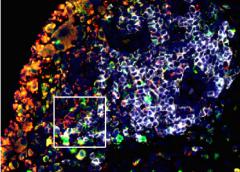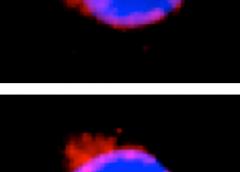
Arthritis is often used to refer to any disorder that affects the joints. Rheumatic diseases usually affect joints, tendons, ligaments, bones, and muscles.
Ankylosing Spondylitis
What is ankylosing spondylitis? It is arthritis that affects the spine, usually producing redness, heat, swelling, and pain in the spine where it joins the pelvis.Arthritis
What is arthritis? It is joint inflammation and though it is a symptom rather than a diagnosis, the term is often used to refer to any disorder affecting the joints.Arthritis and Rheumatic Diseases
Arthritis is often used to refer to any disorder that affects the joints. Rheumatic diseases usually affect joints, tendons, ligaments, bones, and muscles.Autoimmune Diseases
What are autoimmune diseases? These diseases occur when your immune cells attack your body by mistake. These diseases can affect almost any part of the body.Autoinflammatory Diseases
What are autoinflammatory diseases? They cause your immune cells to attack your body by mistake, and can cause fever, rash, joint swelling, and more.Behçet’s Disease
What is Behçet’s disease? It is a chronic condition that causes mouth or genital sores, and inflammation in parts of the eye.Bursitis
What is bursitis? It is a common condition that causes swelling and pain around muscles and bones.Giant Cell Arteritis
What is giant cell arteritis? It causes arteries in the scalp and neck to become red, hot, swollen, or painful. Arteries most affected are those in the temples.Gout
What is gout? It is a kind of arthritis that causes painful and stiff joints. Gout is caused by the build-up of crystals of uric acid in your joints.Hip Replacement Surgery
Hip replacement surgery removes damaged or diseased parts of a hip joint and replaces them with new, man-made parts.Joint Replacement Surgery
Joint replacement surgery removes damaged or diseased parts of a joint and replaces them with new, man-made parts.Juvenile Arthritis
What is juvenile arthritis? It is the term used to describe arthritis in children. Arthritis is caused by inflammation of the joints.Knee Problems
Knee problems happen when you injure or develop disease in your knee and it can’t do its job.Lupus
Lupus happens when the body’s defense system attacks healthy cells and tissues, instead of viruses and bacteria. This can damage many parts of the body.Osteoarthritis
What is osteoarthritis? It damages the slippery tissue that covers the ends of bones, causing bones to rub together, producing pain, swelling, and loss of motion.Polymyalgia Rheumatica
What is polymyalgia rheumatica? It causes muscle pain and stiffness in the neck, shoulder, and hip, and can be accompanied by fever, weakness, and weight loss.Psoriatic Arthritis
What is psoriatic arthritis? It can occur in people who have psoriasis (scaly red and white patches). It affects the joints and areas where tissues attach to bone.Reactive Arthritis
What is reactive arthritis? It is caused by an infection and results in joint pain and swelling. You may also have red, swollen eyes and a swollen urinary tract.Rheumatoid Arthritis
What is rheumatoid arthritis? It is a disease that affects multiple joints, resulting in pain, swelling, and stiffness. Tiredness and fever may also be present.Scleroderma
What is scleroderma? It is a group of diseases causing patches of tight, hard skin. Some forms of scleroderma also damage your blood vessels and internal organs.Shoulder Problems
Most shoulder problems happen when soft tissues in the shoulder region break down. The various causes and symptoms depend on the type of shoulder problem.Sjögren’s Syndrome
What is Sjögren’s syndrome? It is a disease that affects the glands that make moisture. It most often causes dryness in the mouth and eyes.Systemic Lupus Erythematosus (Lupus)
What is lupus? It is a disease where the body’s defense system attacks healthy cells and tissues, causing damage to many parts of the body.Tendinitis
What is tendinitis? It is swelling and pain in a joint usually caused by repeated injuries to a tendon, the part of the joint that connects muscles to bones.Selected Research Areas
Autoimmunity Branch
The branch investigates autoimmunity, a feature of rheumatic diseases, such as lupus, rheumatoid arthritis, and dermatomyositis.Translational Genetics and Genomics Unit
Led by Dr. Michael Ombrello, the unit uses genomic approaches to understand the underlying factors of autoinflammatory and rheumatic diseases.Scientific Publications
Arthritis and Rheumatic Disease News
Research Brief | January 9, 2017
Tofacitinib Shows Potential for Treating Lupus
A drug that effectively treats rheumatoid arthritis (RA) and can improve symptoms in other autoimmune diseases may also control the symptoms associated with systemic lupus erythematosus (SLE or lupus) and potentially slow the disease’s progression.
Spotlight on Research | August 23, 2016
Immune Cell’s Role in Rheumatoid Arthritis-Induced Bone Loss Revealed
Investigators supported in part by the NIH’s National Institute of Arthritis and Musculoskeletal and Skin Diseases (N
Spotlight on Research | May 21, 2016
Same Immune Regulatory Protein Found to Play Instrumental Role in Two Hereditary Autoinflammatory Diseases
Research funded in part by the NIH’s National Institute of Arthritis and Musculoskeletal and Skin Diseases (NIAMS) has revealed a new role for A20, a protein that regulates a key immune response pathway, in certain early-onset autoinflammatory diseases. The results suggest that targeting this pathway could be an effective strategy for treating these diseases, and possibly related conditions, as well.
Spotlight on Research | April 21, 2016
Study Suggests Most Women With Mild to Moderate Lupus Can Expect to Have Healthy Pregnancies
A large, long-term study among women with lupus has yielded important insights into how to predict who may develop pregnancy complications associated with the disease, and who is most likely to have a healthy pregnancy. A related study identified key factors that may put a woman at risk for problems, allowing for early detection and monitoring.
Research Brief | February 23, 2016
Mitochondria Found to Play Instrumental Role in NET Formation and Autoimmune Disease
Neutrophil extracellular traps (NETs) are web-like structures that immune cells called neutrophils use to ensnare and kill microbes such as bacteria or fungi. Some evidence suggests that NETs, which contain an individual’s own cellular proteins and DNA, can trigger an immune reaction to these "self" components and promote autoimmunity.
Announcement | January 13, 2016
NIH Announces Publication of Action Plan for Lupus Research
In response to a request from the Congressional Lupus Caucus, the National Institutes of Health (NIH) has released an Action Plan for Lupus Research. This report was a collaborative effort, led by the National Institute of Arthritis and Musculoskeletal and Skin Diseases (NIAMS) on behalf of the NIH. It represents a synthesis of internal and external input on promising future research directions to improve the lives of people with lupus.
Last Reviewed:






